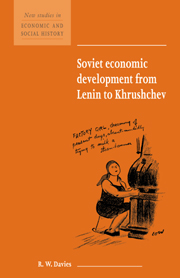Book contents
- Frontmatter
- Contents
- List of maps
- List of figures
- List of tables
- Acknowledgements
- Main dates in Russian and Soviet history
- Glossary
- Map 1 Republics, cities and major towns of the USSR at the end of the 1930s
- Map 2 Agricultural regions of the USSR (including the Virgin Lands)
- Map 3 Industrial regions of the USSR
- 1 Introduction
- 2 The Tsarist economy
- 3 War Communism, 1918–1920
- 4 The New Economic Policy of the 1920s
- 5 Measuring Soviet economic growth
- 6 Soviet economic development, 1928–1965
- 7 The Soviet economic system, 1928–1965
- 8 Soviet industrialisation in perspective
- Further reading
- References
- Index
- Cambridge Cultural Social Studies
7 - The Soviet economic system, 1928–1965
Published online by Cambridge University Press: 06 January 2010
- Frontmatter
- Contents
- List of maps
- List of figures
- List of tables
- Acknowledgements
- Main dates in Russian and Soviet history
- Glossary
- Map 1 Republics, cities and major towns of the USSR at the end of the 1930s
- Map 2 Agricultural regions of the USSR (including the Virgin Lands)
- Map 3 Industrial regions of the USSR
- 1 Introduction
- 2 The Tsarist economy
- 3 War Communism, 1918–1920
- 4 The New Economic Policy of the 1920s
- 5 Measuring Soviet economic growth
- 6 Soviet economic development, 1928–1965
- 7 The Soviet economic system, 1928–1965
- 8 Soviet industrialisation in perspective
- Further reading
- References
- Index
- Cambridge Cultural Social Studies
Summary
The preceding account has shown that the economic system took shape in the early 1930s under the rival influences of ideology and economic necessity. Its major features, established by the mid- 19305, continued more or less unchanged throughout the upheavals of the next half-century. Let us summarise the system as it operated at the time of Stalin's death. Modifications introduced by Khrushchev and others will be considered later in this chapter.
First, as we have seen, agriculture as well as industry was under close state control. State farms (sovkhozy) produced a fairly small proportion of total agricultural output. The vast majority of the 25 million peasant households which existed in 1929 were combined into some 250,000 collective farms (kolkhozy). In the early 1950s the smaller kolkhozy were amalgamated, and the total number was reduced to about 50,000. Most land was pooled, and worked in common. Agricultural machinery was made available to the kolkhozy through some 8,000 state-owned Machine-Tractor Stations. Through the system of compulsory deliveries the kolkhozy were required to supply a large part of their output to the state collection agencies at low fixed prices.
Secondly, within industry, production and investment were administered through physical controls. Prices were fixed, and materials and capital equipment were distributed to existing factories and new building sites through an allocation system. The state sought through central allocations to give priority to key construction projects and to overcome the bottlenecks in existing industries. The plan set targets for the output of materials, intermediate products and final products. These planning methods resembled both War Communism and the wartime planning controls used in capitalist economies to shift resources to the war effort.
- Type
- Chapter
- Information
- Soviet Economic Development from Lenin to Khrushchev , pp. 73 - 78Publisher: Cambridge University PressPrint publication year: 1998



